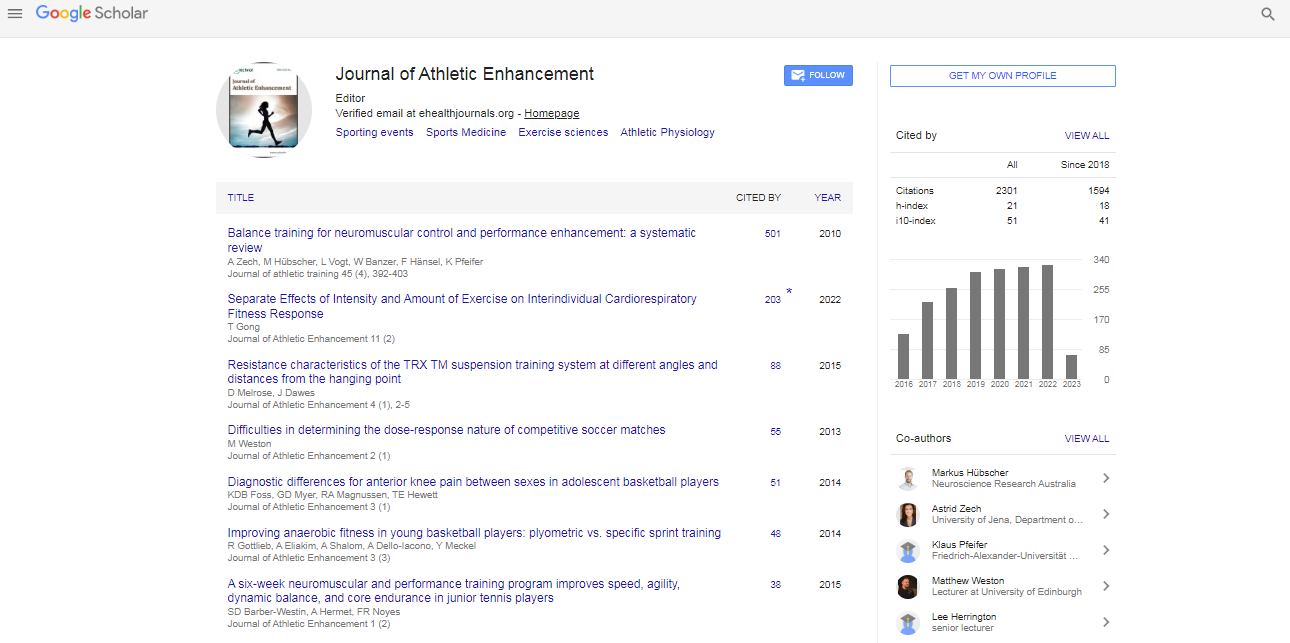Opinion Article, J Athl Enhanc Vol: 13 Issue: 3
Athletic Physiology: The Science Behind Peak Performance
Jian Guo*
1Department of Sports Medicine, Peking University Third Hospital, Beijing, China
*Corresponding Author: Jian Guo,
Department of Sports Medicine, Peking
University Third Hospital, Beijing, China
E-mail: guojian@edu.cn
Received date: 26 April, 2024, Manuscript No. JAE-24-137879;
Editor assigned date: 29 April, 2024, PreQC No. JAE-24-137879 (PQ);
Reviewed date: 14 May, 2024, QC No. JAE-24-137879;
Revised date: 20 May, 2024, Manuscript No. JAE-24-137879 (R);
Published date: 27 May, 2024, DOI: 10.4172/2324-9080.1000128
Citation: Guo J (2024) Athletic Physiology: The Science Behind Peak Performance. J Athl Enhanc 13:3.
Description
Athletic physiology is a multidisciplinary field that delves into the complex interactions between the human body and physical activity. It encompasses various physiological systems, including the cardiovascular, respiratory, muscular, and nervous systems, all of which play crucial roles in determining an athlete's performance. The cardiovascular system, consisting of the heart, blood vessels, and blood, is responsible for transporting oxygen, nutrients, and waste products throughout the body. During exercise, the demand for oxygen and nutrients increases significantly, leading to various adaptations within the cardiovascular system to meet these demands.
One of the primary adaptations is an increase in cardiac output, achieved through an elevation in heart rate and stroke volume. With regular exercise, the heart becomes more efficient at pumping blood, resulting in a lower resting heart rate and enhanced cardiac function. Additionally, exercise promotes the dilation and remodeling of blood vessels, improving blood flow to working muscles and enhancing oxygen delivery. The respiratory system plays a vital role in supplying oxygen to the body and removing carbon dioxide, which is produced as a byproduct of metabolism. During exercise, the respiratory rate and depth of breathing increase to meet the heightened oxygen demand of working muscles.
Regular exercise leads to improvements in respiratory function, including increased lung capacity, enhanced gas exchange efficiency, and improved respiratory muscle strength. These adaptations enable athletes to extract oxygen from the air more effectively and deliver it to the bloodstream, improving overall aerobic capacity and endurance. The muscular system is central to athletic performance, as it is responsible for generating force and producing movement. Muscles adapt to the demands of exercise through a process known as hypertrophy, whereby muscle fibers increase in size and strength in response to resistance training.
In addition to hypertrophy, endurance training stimulates the development of slow-twitch muscle fibers, which are rich in mitochondria and highly resistant to fatigue. These fibers are crucial for sustained, low-intensity activities such as long-distance running or cycling. Neuromuscular coordination refers to the intricate interaction between the nervous system and muscles to produce precise movements. Through practice and repetition, athletes develop enhanced neuromuscular efficiency, allowing them to execute movements with greater accuracy, speed, and precision.
Coordination and skill acquisition are fundamental aspects of athletic performance, requiring the integration of sensory feedback, motor control, and muscle activation. Training programs aimed at improving neuromuscular coordination often incorporate drills, exercises, and sport-specific activities to optimize movement patterns and enhance performance. Exercise has profound effects on metabolism, influencing energy production, substrate utilization, and metabolic efficiency. During high-intensity exercise, the body relies primarily on anaerobic metabolism to generate energy rapidly. This process produces lactate as a byproduct, leading to muscle fatigue and discomfort.
With consistent training, however, the body becomes more efficient at utilizing oxygen for energy production, shifting towards aerobic metabolism. Aerobic training promotes mitochondrial biogenesis, increases oxidative enzyme activity, and enhances fat oxidation, allowing athletes to sustain higher levels of intensity for longer durations. Environmental conditions can significantly impact athletic performance, influencing thermoregulation, hydration status, and nutrient availability. Extreme temperatures, humidity, altitude, and air quality can all pose challenges to athletes, necessitating adaptations and strategic interventions to optimize performance.
Athletes competing in hot and humid conditions must prioritize hydration and electrolyte balance to prevent heat-related illnesses such as heat exhaustion or heat stroke. Similarly, individuals training or competing at high altitudes experience reduced oxygen availability, prompting physiological adaptations such as increased red blood cell production and improved oxygen transport capacity. Recovery is an essential component of athletic training, allowing the body to repair, regenerate, and adapt to the stresses imposed by exercise. Adequate rest, nutrition, hydration, and sleep are critical for optimizing recovery and maximizing performance gains.
Periodization, or the strategic planning of training phases, allows athletes to balance workload and recovery to achieve peak performance during competition. By alternating between periods of high-intensity training and recovery, athletes can stimulate physiological adaptations while minimizing the risk of overtraining and injury. Athletic physiology is a dynamic and multifaceted field that underpins the science of human performance. By understanding the physiological mechanisms underlying exercise adaptation and performance, athletes, coaches, and sports scientists can design effective training programs, optimize performance strategies, and promote long-term health and athletic success. From cardiovascular adaptations to neuromuscular coordination and metabolic efficiency, the intricate interplay of physiological systems shapes the capabilities and limits of the athletic body, driving achievements in sport and human potential.
 Spanish
Spanish  Chinese
Chinese  Russian
Russian  German
German  French
French  Japanese
Japanese  Portuguese
Portuguese  Hindi
Hindi 
